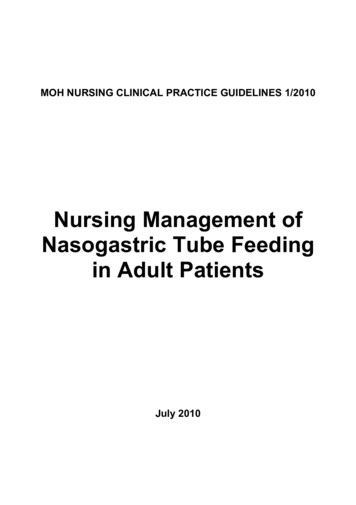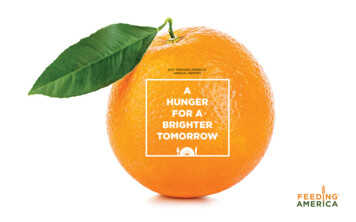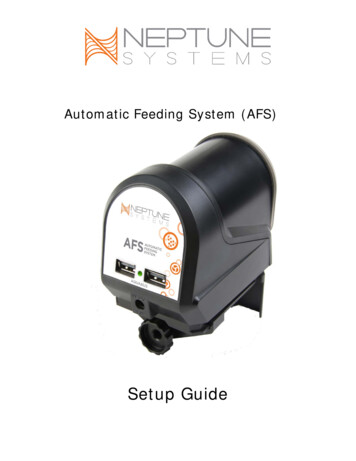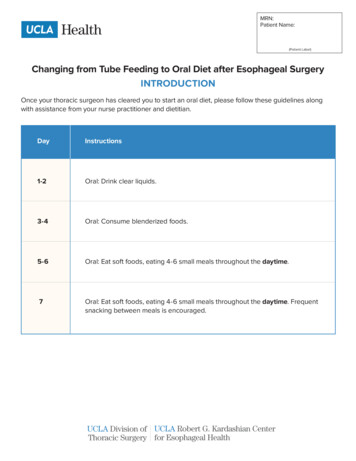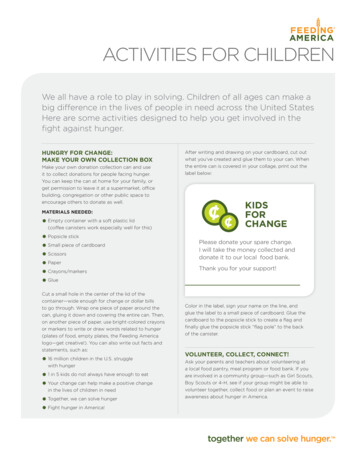
Transcription
ACTIVITIES FOR CHILDRENWe all have a role to play in solving. Children of all ages can make abig difference in the lives of people in need across the United StatesHere are some activities designed to help you get involved in thefight against hunger.HUNGRY FOR CHANGE:MAKE YOUR OWN COLLECTION BOXMake your own donation collection can and useit to collect donations for people facing hunger.You can keep the can at home for your family, orget permission to leave it at a supermarket, officebuilding, congregation or other public space toencourage others to donate as well.MATERIALS NEEDED: Empty container with a soft plastic lid(coffee canisters work especially well for this) Popsicle stick Small piece of cardboard Scissors Paper Crayons/markers GlueCut a small hole in the center of the lid of thecontainer—wide enough for change or dollar billsto go through. Wrap one piece of paper around thecan, gluing it down and covering the entire can. Then,on another piece of paper, use bright-colored crayonsor markers to write or draw words related to hunger(plates of food, empty plates, the Feeding Americalogo—get creative!). You can also write out facts andstatements, such as: 16 million children in the U.S. strugglewith hunger 1 in 5 kids do not always have enough to eat Your change can help make a positive changein the lives of children in need Together, we can solve hunger Fight hunger in America!After writing and drawing on your cardboard, cut outwhat you’ve created and glue them to your can. Whenthe entire can is covered in your collage, print out thelabel below:KIDSFORCHANGEPlease donate your spare change.I will take the money collected anddonate it to our local food bank.Thank you for your support!Color in the label, sign your name on the line, andglue the label to a small piece of cardboard. Glue thecardboard to the popsicle stick to create a flag andfinally glue the popsicle stick “flag pole” to the backof the canister.VOLUNTEER, COLLECT, CONNECT!Ask your parents and teachers about volunteering ata local food pantry, meal program or food bank. If youare involved in a community group—such as Girl Scouts,Boy Scouts or 4-H, see if your group might be able tovolunteer together, collect food or plan an event to raiseawareness about hunger in America.
ACTIVITIES FOR CHILDRENCOLOR FOR CHANGE!WRITE ALL ABOUT IT. (POEM OR STORY)Use the coloring sheets below. Color the sheets in andshare them wherever you would like. You could displaythem on your fridge, give them to your teacher to hangup at school or to your parents to share at their office.Color a few and share them everywhere!How does someone become hungry or homeless? Howdoes being hungry make a person feel? Write a poem orstory describing hunger, and then consider sharing yourstory or poem at school, with your family, or even sendingit to a local newspaper or to a children’s magazine.READ ALL ABOUT IT!Another way to take action against hunger is tolearn more about hunger, and read books thatexplore community building and helping others.There are a lot of great books out there for kidsof all ages about the realities of hunger—here arejust a few of them: A Kids’ Guide to Hunger & Homelessness:How to Take Action! by Cathryn Berger Kaye Willie and the Soup Kitchen Uncle(Reading Rainbow Book) by Dyanne Disalvo-Ryan B eatrice’s Goat by Page McBrier T he Peace Book by Todd Parr S tone Soup by Marcia BrownKIDSFORCHANGEWRITE ALL ABOUT IT.(LETTER TO THE EDITOR)No matter how old you are, orhow young you are, your voiceis an important one. Write a letterto the editor of your local newspaperexpressing your thoughts and howyou feel about hunger in America.Whether you read a book,volunteered, have been collectingdonations, or whatever action you’retaking—share your experiences! Hereis a template to help you get startedwith your letter—it’s just a startingpoint, feel free to use it as a guideor create your own letter.Dear Editor,My name isand I am inWRITE YOURgrade attheR GRADEYOUNAME HERE.E HERESCHOOL NAMWRITE YOURin the Uniteding right hererldwide, includwoueissusseriolvinge hunger is ale to play in sos letter because all have a roI am writing thiwith hunger. Weglugstrlemillion peopTOEND HUNGERerica today, 49ATDO TO HELPNStates. In AmPLAYOUging toABOUT WHll.WRITE YOURpart. I am plede action as wewant to do mypeople will takhunger, and Ipe that otherhomyisIt.nger in the U.Sto help fight huthis monthlveer, we can soWorking togethSincerely,rence.ly make a diffehunger and tru
CONVERSATION STARTERSWe all have a role to play in getting food to those in need. Sharinginformation and raising awareness about hunger is a great place tostart. Here are some conversation starters that can be used at dinnerparties (consider placing them as placards/in place of name cards atsit-down dinners), in classrooms or at book clubs—anywhere peopleare gathering and up for discussing an important issue.FOOD INSECURITY IN AMERICA.OLD AND YOUNGIt may be difficult to believe that in America—a nationof plenty—millions face hunger. In our country today,49 million people are food insecure, meaning they donot always know where their next meal is coming from.Yet, it does not have to be like this. Hunger is solvable,and the Feeding America network of food banks isfighting it in every county in the United States. Discoverhow you can help by finding and connecting with yourlocal food bank through the food bank finder foundon feedingamerica.org.Nearly 16 million—or 1 in 5—children in Americastruggle with hunger.* At the same time, 33 percentof the households Feeding America serves havea member age 60 or older.**How does hunger impact our nation’s most vulnerablepopulations? What immediate effects might hungerhave on older adults? What kind of long-term effectsdoes hunger have on children? To learn more aboutthe long-term impact of hunger on children, see“Child Hunger Facts” under the “Hunger Facts” linkon feedingamerica.org.ONE IN 6Based on statistics from the United States Departmentof Agriculture, we know that 1 in 6 Americans struggleswith hunger each year. One out of every six people,right here in our own country. How many people work atyour office? How many students are in your classroom?How many people belong to your church, synagogueor mosque?What does the statistic“1 in 6” mean to you?How many people doyou think might bestruggling with hungerin your community?*** SOURCE: 2013 USDA Data*** SOURCE: 2014 Feeding America “Hunger in America” report*** SOURCE: 2014 Feeding America “Hunger in America” reportWORKING—AND STILL HUNGRYFifty-four percent of the households served by theFeeding America network were employed within thelast year.*** “Hungry” doesn’t equal “homeless” or“unemployed”—many people are employed and stillnot able to make ends meet. How does that changeour perception about what it means to be hungryin America? How does that change our perceptionabout what it means to be living in poverty?
CHILD HUNGER QUIZDid you know ?Each year, millions of children (in fact, 1 in 5) can’t get the foodthey need. Many of your classmates may not have enough to eat,and you may not even know it. It isn’t always easy to see hunger.But it makes kids feel sleepy, sad and anxious, and it makes ithard for them to concentrate.What does it feel likewhen you are hungry?What kinds of emotions doyou feel when you are hungry?How does your body feel?Do you feel like running, jumpingand playing? or Do you feel tired?How does your head feel?HAPPYSADANGRYIs it easy to concentrate and comeup with answers at school?OR Are you thinking about lunch?ANXIOUSSCARED
Draw a healthy meal on your plate.
Another way to take action against hunger is to learn more about hunger, and read books that explore community building and helping others. There are a lot of great books out there for kids of all ages about the realities of hunger—here are just a few of them: A Kids' Guide to Hunger & Homelessness: How to Take Action! by Cathryn Berger .

